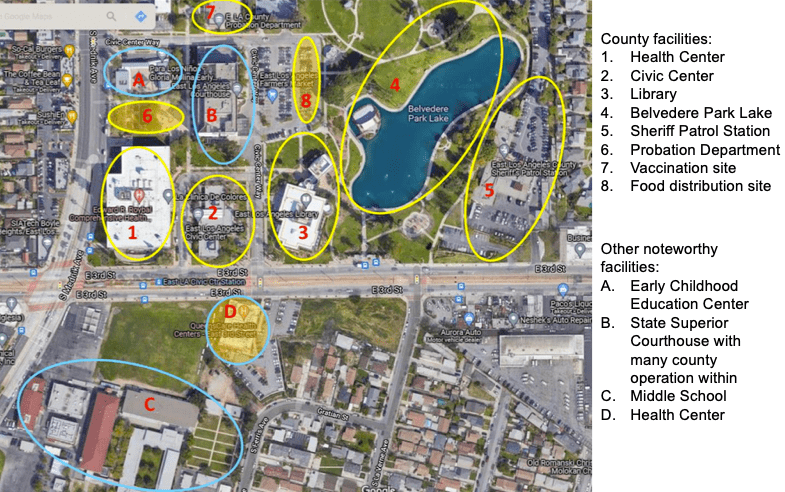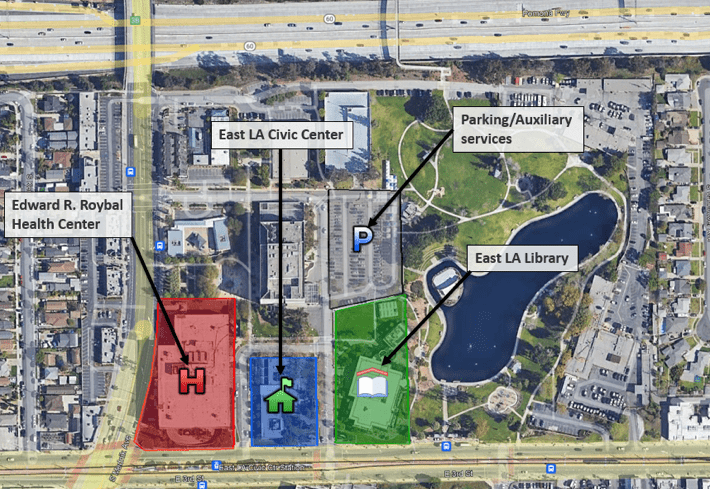
Bringing resilience to a disadvantaged community in East Los Angeles
In partnership with Los Angeles County, the Clean Coalition is assessing the feasibility of Solar Microgrids for a hub of critical community facilities.
The Clean Coalition has partnered with Los Angeles (LA) County to unleash Solar Microgrids and Community Microgrids that deliver unparalleled economic, environmental, and resilience benefits to communities, starting with disadvantaged communities.
As the first step in this collaboration, the Clean Coalition will perform Solar Microgrid feasibility studies for a hub of LA County critical community facilities (CCFs) that are clustered in the disadvantaged and unincorporated East LA community.

The Clean Coalition will begin by assessing the feasibility of Solar Microgrids that incorporate solar, storage, and load management solutions to deliver economic, environmental, and resilience benefits to the following three types of LA County CCFs in the East LA hub, along with an adjacent parking areas that support auxiliary emergency services:
- Health Center
- Civic Center
- Library

The associated assessments will evaluate solar siting opportunities, resilience requirements based on critical loads and energy storage sizing and siting, and economic expectations based on cash-purchase and Power Purchase Agreement (PPA) financing options. Also, the Clean Coalition will analyze opportunities to reduce reliance on the grid during peak demand periods and will facilitate stakeholder discussions that include Southern California Edison (SCE), the serving utility; Clean Power Alliance (CPA), the serving Community Choice Aggregator (CCA); State of California policymakers; and community benefit organizations (CBOs) in the region. Importantly, opportunities for encompassing the East LA Solar Microgrids into a state-of-the-art East LA Community Microgrid will be fully considered, with SCE being heavily encouraged to support its first Community Microgrid in this high-visibility location.
The East LA Solar Microgrids feasibility studies are intended to stage unparalleled community resilience by ensuring that the most vital CCF services are always available, including during grid outages of any duration. The use of existing diesel generators will be minimized or eliminated while economic, environmental, health, and safety benefits are maximized for everyone throughout the community.
Potentially, a Community Microgrid financed through a Resilient Energy Subscription (RES) will also be staged to extend solar-driven resilience benefits to additional facilities, including businesses and residences within the initial target grid area of a prospective East LA Community Microgrid. RES, a straightforward market mechanism to facilitate the financing and expansion of Community Microgrids, allows any facility within the footprint of a Community Microgrid to pay a simple, transparent fee on top of its normal electricity tariff for guaranteed daily delivery of locally generated renewable energy during grid outages – ensuring unparalleled energy resilience. The RES fee covers the cost of service of provisioning such energy resilience from a Community Microgrid.
The East LA hub is located within a disadvantaged community (DAC) that scores 89 in CalEnviroScreen 4.0:

The Clean Coalition analyses will assume new EV Charging Infrastructure (EVCI) that is configured behind-the-meter (BTM) to meet LA County plans of Level-2 charging for at least 5% of all parking spots. The BTM configuration is required to ensure EV charging resilience for critical transportation needs during grid outages. Load management solutions, including controllable EVCI, will be identified to ensure that BTM EV charging can provide both economic and resilience benefits.
The Clean Coalition will utilize its value-of-resilience (VOR) methodology, which tiers loads into three categories: Tier 1 for critical loads, Tier 2 for priority loads, and Tier 3 for discretionary loads. The Clean Coalition’s methodology, called VOR123, is designed to ensure 100% resilience for Tier 1 loads (always served), high resilience for Tier 2 loads, and significant resilience for the remaining loads, which are Tier 3 and totally discretionary.
LA County’s ultimate goal is to implement Solar Microgrids and Community Microgrids throughout the County. As such, the Solar Microgrid feasibility studies for the East LA hub are intended to be translated into a Request for Proposals (RFP) that leads to robust Solar Microgrid implementations within the next two years. The East LA Solar Microgrids are intended to showcase Solar Microgrids that can be proliferated to CCFs throughout LA County and beyond.

